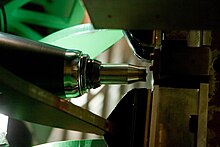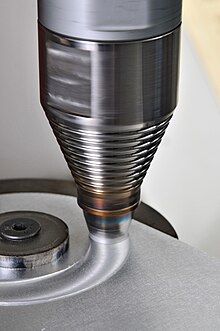
Back لحام احتكاكي حركي Arabic Soldadura per fricció-agitació Catalan Třecí svařování promíšením Czech Reibschweißen#Rührreibschweißen German Soldadura por fricción-agitación Spanish Hõõrdkeevitus Estonian جوشکاری همزن اصطکاکی Persian Soudage par friction malaxage French Friction Stir Welding Italian 摩擦攪拌接合 Japanese




Friction stir welding (FSW) is a solid-state joining process that uses a non-consumable tool to join two facing workpieces without melting the workpiece material.[1][2] Heat is generated by friction between the rotating tool and the workpiece material, which leads to a softened region near the FSW tool. While the tool is traversed along the joint line, it mechanically intermixes the two pieces of metal, and forges the hot and softened metal by the mechanical pressure, which is applied by the tool, much like joining clay, or dough.[2] It is primarily used on wrought or extruded aluminium and particularly for structures which need very high weld strength. FSW is capable of joining aluminium alloys, copper alloys, titanium alloys, mild steel, stainless steel and magnesium alloys. More recently, it was successfully used in welding of polymers.[3] In addition, joining of dissimilar metals, such as aluminium to magnesium alloys, has been recently achieved by FSW.[4] Application of FSW can be found in modern shipbuilding, trains, and aerospace applications.[5][6][7][8][9][10]
The concept was patented in the Soviet Union by Yu. Klimenko in 1967,[11] but it wasn't developed into a commercial technology at that time. It was experimentally proven and commercialized at The Welding Institute (TWI) in the UK in 1991. TWI held patents on the process, the first being the most descriptive.[12]
- ^ Li, Kun; Jarrar, Firas; Sheikh-Ahmad, Jamal; Ozturk, Fahrettin (2017). "Using coupled Eulerian Lagrangian formulation for accurate modeling of the friction stir welding process". Procedia Engineering. 207: 574–579. doi:10.1016/j.proeng.2017.10.1023.
- ^ a b "Welding process and its parameters - Friction Stir Welding". www.fswelding.com. Archived from the original on 2020-07-22. Retrieved 2017-04-22.
- ^ Sheikh-Ahmad, J.Y.; Ali, Dima S.; Deveci, Suleyman; Almaskari, Fahad; Jarrar, Firas (February 2019). "Friction stir welding of high density polyethylene—Carbon black composite". Journal of Materials Processing Technology. 264: 402–413. doi:10.1016/j.jmatprotec.2018.09.033. S2CID 139970404.
- ^ Hou, Z.; Sheikh-Ahmad, J.; Jarrar, F.; Ozturk, F. (2018-05-01). "Residual Stresses in Dissimilar Friction Stir Welding of AA2024 and AZ31: Experimental and Numerical Study". Journal of Manufacturing Science and Engineering. 140 (5). doi:10.1115/1.4039074. ISSN 1087-1357.
- ^ "Practical use of FSW - Friction Stir Welding". www.fswelding.com. Retrieved 2017-04-22.
- ^ Cite error: The named reference
LCSwas invoked but never defined (see the help page). - ^ Cite error: The named reference
C-17 & 747was invoked but never defined (see the help page). - ^ Cite error: The named reference
:1was invoked but never defined (see the help page). - ^ Cite error: The named reference
DSBwas invoked but never defined (see the help page). - ^ Cite error: The named reference
:2was invoked but never defined (see the help page). - ^ "METHOD OF WELDING METAL BY Friction".
- ^ Thomas, WM; Nicholas, ED; Needham, JC; Murch, MG;Temple-Smith, P;Dawes, CJ.Friction-stir butt welding, GB Patent No. 9125978.8, International patent application No. PCT/GB92/02203, (1991)